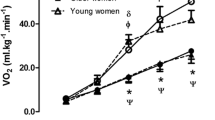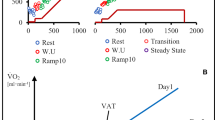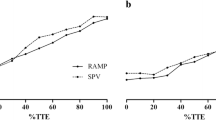Abstract
We investigated the physiological responses in older men to continuous (CEx) and intermittent (IEx) exercise. Nine men [70.4 (1.2) years, V̇O2peak: 2.21 (0.20) l min−1; mean (SE)] completed eight exercise tests (two CEx and six IEx) on an electronically braked cycle ergometer in random order. CEx and IEx were performed at 50% and 70% V̇O2peak. IEx was performed using 60sE:60sR, 30sE:30sR and 15sE:15sR exercise to rest ratios. The duration of exercise was adjusted so that the total amount of work completed was the same for each exercise test. Oxygen uptake (V̇O2), minute ventilation (V̇ E) and heart rate (HR) were measured at the mid-point of each exercise test. Arterialised blood samples were obtained at rest and during exercise and analysed for pH and PCO2. At the same relative intensity (50% or 70% V̇O2peak), IEx resulted in a significantly lower (P<0.01) V̇O2, V̇ E and HR than CEx. There were no significant differences (P>0.05) in V̇O2, V̇ E and HR measured at the mid point of the three exercise to rest ratios at 50% and 70% V̇O2peak. pH and PCO2 during CEx and IEx at 50% V̇O2peak were not significantly different from rest. CEx performed at 70% V̇O2peak resulted in significant decreases (P<0.05) in pH and PCO2. There was a significant decrease (P<0.05) in pH only during the 60sE:60sR IEx at 70% V̇O2peak. Changes in arterialised PCO2 during the 60sE:60sR, 30sE:30sR and 15sE:15sR at both 50% and 70% V̇O2peak exercise tests were not significant. When exercising at the same percentage of V̇O2peak and with the total amount of work fixed, IEx results in significantly lower physiological responses than CEx in older men. All results are given as mean (SE).

Similar content being viewed by others
References
Åstrand I, Åstrand P, Christensen E, Hedman R (1960a) Myoglobin as an oxygen-store in man. Acta Physiol Scand 48:454–460
Åstrand I, Åstrand P-O, Christensen EH, Hedman R (1960b) Intermittent muscular work. Acta Physiol Scand 48:448–453
Babcock MA, Paterson DH, Cunningham DA (1994) Effects of aerobic endurance exercise on gas exchange kinetics of older men. Med Sci Sports Exerc 26:447–52
Ballor DL, Volovsek AJ (1992) Effect of exercise to rest ratio on plasma lactate concentration at work rates above and below maximum oxygen uptake. Eur J Appl Physiol 65:365–369
Christensen EH, Hedman R, Holmdahl I (1960a) The influence of rest pauses on mechanical efficiency. Acta Physiol Scand 48:443–447
Christensen EH, Hedman R, Saltin B (1960b) Intermittent and continuous running. Acta Physiol Scand 50:269–286
Essen B (1978) Studies on the regulation of metabolism in skeletal muscle using intermittent exercise as an experimental model. Acta Physiol Scand [Suppl] 454:3–32
Essen B, Kaijser L (1978) Regulation of glycolysis in intermittent exercise in man. J Physiol (Lond) 281:499–511
Gaesser GA, Poole DC (1996) The slow component of oxygen uptake kinetics in humans. Exerc Sports Sci Rev . 24:35–70
Gaitanos GC, Williams C, Boobis LH, Brooks S (1993) Human muscle metabolism during intermittent maximal exercise. J Appl Physiol 75:712–719
Hagberg JM, Graves JE, Limacher M, Woods DR, Leggett SH, Cononie C, Pollock ML (1989) Cardiovascular responses of 70–79 year old men and women to exercise training. J Appl Physiol 66:2589–2594
Jones NL (1987) Blood gases and acid base physiology. Thieme, New York
Margaria R, Mangila F, Cuttica F, Cerretelli P (1965) The kinetics of oxygen consumption at the onset of muscular exercise in man. Ergonomics 8:49–54
McLellan TM, Gass GC (1989) Metabolic and respiratory responses relative to the anaerobic threshold. Med Sci Sports Exerc 21:191–198
Morris N, Gass G, Thompson M, Bennett G, Basic D, Morton H (2002) Rate and amplitude of adaptation to intermittent and continuous exercise in older men. Med Sci Sports Exerc 34:471–477
Overend TJ, Cunningham DA, Paterson DH, Smith WDF (1992) Physiological responses of young and elderly men to prolonged exercise at critical power. Eur J Appl Physiol 64:187–193
Saltin B, Essen B, Pederson PK (1976) Intermittent exercise: its physiology and some practical applications. Med Sport 9:23–51
Schneider D, Phillips S, Stoffolano S (1993) The simplified V-slope method of detecting the gas exchange threshold. Med Sci Sports Exerc 25:1180–1184
Scott CB (1993) Resting metabolic rate variability as influenced by mouthpiece and noseclip practice procedures. J Burn Care Rehabil 14:573–577
Spriet LL, Lindinger MI, McKelvie RS, Heigenhauser GJ, Jones NL (1989) Muscle glycogenolysis and H+ concentration during maximal intermittent cycling. J Appl Physiol 66:8–13
Stepto NK, Martin DT, Fallon KE, Hawley JA (2001) Metabolic demands of intense aerobic exercise in competitive cyclists. Med Sci Sports Exerc 33:303–310
Whipp BJ, Davis JA, Torres F, Wasserman K (1981) A test to determine parameters of aerobic function during exercise. J Appl Physiol 50:217–221
Williams JS, Babb TG (1997) Differences between estimates and measured P aCO2 during rest and exercise in older subjects. J Appl Physiol 83:312–316
Author information
Authors and Affiliations
Corresponding author
Rights and permissions
About this article
Cite this article
Morris, N., Gass, G., Thompson, M. et al. Physiological responses to intermittent and continuous exercise at the same relative intensity in older men. Eur J Appl Physiol 90, 620–625 (2003). https://doi.org/10.1007/s00421-003-0918-z
Accepted:
Published:
Issue Date:
DOI: https://doi.org/10.1007/s00421-003-0918-z




